Search Results for Tag: Earthquake
Steck: “The only way I can help the people of Nepal”
There are only 20 days left until Ueli Steck will return to Nepal. To the country where the 38-year-old Swiss top climber in the same year celebrated his probably most spectacular success as an extreme climber as well as the greatest fear of death that had nothing to do with mountain dangers. In spring 2013, a group of angry Sherpas attacked Ueli and his teammates Simone Moro and Jonathan Griffith in Everest high camp and threatened them with death. In fall 2013, Steck reached the 8091-meter-high summit of Annapurna, the eight-thousander with the highest fatality rate: solo, via the extremely dangerous South Face, on a partly new route, as always without bottled oxygen. It took Ueli only 28 hours to climb up and down.
This summer, he proved once again that he is able to climb mountains lickety-split, when he – as reported in my blog – scaled all 82 four-thousanders of the Alps within 62 days and overcame the distance between the mountains without engine power: by hiking, cycling or paragliding. I talked to Ueli about his tour de force through the Alps – and also about his upcoming exciting project in Nepal: on Nuptse, within sight of Mount Everest.
![]() read more
read more
PR with a permit
The despair in Nepal must be great. There is no other explanation for the fact that the government in Kathmandu called a press conference these days only to hand out a permit for an expedition. Japanese climber Nobukazu Kuriki received the written permission to climb Mount Everest this fall from the hands of Tourism Minister Kripasur Sherpa. “Kuriki is climbing at a time when there is confusion in the world about the safety in Nepal after the earthquake”, the Minister said. “This will be an example for other visitors to come to Nepal which is safe for mountain climbing.” The 33-year-old Japanese climber sang the same tune: “The main purpose of my climb is to spread the message that Nepal is safe for climbers and trekkers even after the earthquake.”
Kuriki – as reported – wants to climb Everest from the Nepal side, after the Chinese authorities gave all expeditions to Tibet the cold shoulder. Today Kuriki flew from Kathmandu to the Khumbu region for acclimatization. In 2012, in his last attempt to climb Everest in fall, the Japanese had suffered severe frostbite. Nine fingers had to be amputated. Like then, Kuriki again plans to climb solo and without bottled oxygen, this time on the normal route. The “Icefall Doctors” will prepare for him the route through the Khumbu Icefall.
![]() read more
read more
Nepal now? Absolutely!
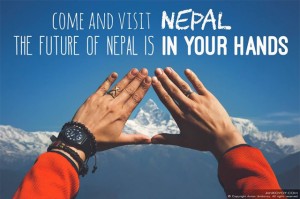 The financial aftershock is probably unavoidable. But it is important to keep the vibrations for Nepal within limits. The fall trekking season is just around the corner, and the government anticipates a dramatic 50 percent slump in tourism. “The number of foreign tourists has declined after the earthquake”, says Tourism Minister Kripasur Sherpa. “This is a heavy burden, because tourism is very important for the Nepalese economy and people.” The Government points out that international independent earthquake experts have declared the most popular trekking routes in Nepal, the Annapurna Circuit and the Everest Base Camp Trek, for nonhazardous. “Tourists don’t take higher risks any more”, says Kripasur Sherpa.
The financial aftershock is probably unavoidable. But it is important to keep the vibrations for Nepal within limits. The fall trekking season is just around the corner, and the government anticipates a dramatic 50 percent slump in tourism. “The number of foreign tourists has declined after the earthquake”, says Tourism Minister Kripasur Sherpa. “This is a heavy burden, because tourism is very important for the Nepalese economy and people.” The Government points out that international independent earthquake experts have declared the most popular trekking routes in Nepal, the Annapurna Circuit and the Everest Base Camp Trek, for nonhazardous. “Tourists don’t take higher risks any more”, says Kripasur Sherpa.
![]() read more
read more
Money for relief flights in Nepal runs short
The World Food Programme (WFP) has sounded the alarm. If the “United Nations Humanitarian Air Service” (UNHAS) does not receive additional money, the helicopter relief flights for the earthquake victims in Nepal have to be stopped at the end of August. According to the WFP, which manages the UNHAS, there is a shortfall of more than nine million US dollars to continue the flights as scheduled until the end of October.
![]() read more
read more
Get ready to trek to Everest!
A cautious all-clear for the Everest Base Camp trail. “None of the major suspension bridges appear to be affected by new geotechnical hazards as a result of the earthquake”, says the report of a group of mountain guides and engineers of the US based agency Miyamoto International which is specialized on earthquake damage. “Much of the trail and most of the rock retaining walls (both above and below) the trail are undamaged. We have observed very little foundation damage to buildings.” At the end of June the team had assessed the condition of the trail from the village of Lukla to Everest Base Camp after the devastating earthquake of 25 April and the aftermaths. 83 percent of the observed lodges and houses were given a green tag, meaning that they were undamaged or hardly affected. And the others?
![]() read more
read more
Education in tin sheds
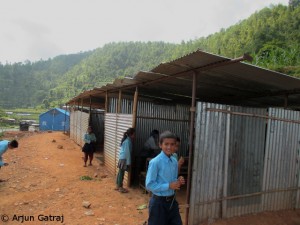 A return to normal is difficult while you have to live in ruins. “The earthquake has destroyed almost all the houses”, Arjun Gatraj wrote to me from Thulosirubari in Sindhupalchowk District. The village is about 40 kilometers as the crow flies from the Nepalese capital Kathmandu, but is only accessible by a gravel road. “The people are struggling to make ends meet. They live from hand to mouth”, Arjun said. According to him, the devastating 25 April earthquake killed about 75 people in Thulosirubari. Seven of the victims were students of the “Gerlinde and Ralf School”, but they didn’t die at school. “When I heard about the earthquake, I had many familiar people of Nepal in my mind: friends, good friends, and of course the many children in the various schools of the German aid organization Nepalhilfe Beilngries, also the students of the school in Thulosirubari”, says Gerlinde Kaltenbrunner. “Then my thought was immediately: Saturday is no school, thank goodness!” With their financial commitment, the extreme climbers Gerlinde Kaltenbrunner and Ralf Dujmovits had made it possible at all to build the school.
A return to normal is difficult while you have to live in ruins. “The earthquake has destroyed almost all the houses”, Arjun Gatraj wrote to me from Thulosirubari in Sindhupalchowk District. The village is about 40 kilometers as the crow flies from the Nepalese capital Kathmandu, but is only accessible by a gravel road. “The people are struggling to make ends meet. They live from hand to mouth”, Arjun said. According to him, the devastating 25 April earthquake killed about 75 people in Thulosirubari. Seven of the victims were students of the “Gerlinde and Ralf School”, but they didn’t die at school. “When I heard about the earthquake, I had many familiar people of Nepal in my mind: friends, good friends, and of course the many children in the various schools of the German aid organization Nepalhilfe Beilngries, also the students of the school in Thulosirubari”, says Gerlinde Kaltenbrunner. “Then my thought was immediately: Saturday is no school, thank goodness!” With their financial commitment, the extreme climbers Gerlinde Kaltenbrunner and Ralf Dujmovits had made it possible at all to build the school.
![]() read more
read more
Aid project: School up!
It looked as if the magician David Copperfield had staged one of his grand illusions. “The school was much smaller than I remembered it”, Ralf Dujmovits tells me. “First I didn’t even realize that the ground floor had just slumped down. The upper parts of the building were still standing. Only when I got loser, I saw the extent of damage. That really brought tears to my eyes.” Germany’s most successful high altitude climber visited the “Gerlinde and Ralf School” in Thulosirubari one and a half weeks after the devastating earthquake in Nepal. Gerlinde Kaltenbrunner and Ralf Dujmovits had given financial support to the project of the German aid organization “Nepalhilfe Beilngries” and thus had made it possible that the school had been opened in 2009. “If you suddenly realize that the building has to be demolished, you just begin to cry”, says Ralf. You all can help to rebuild the school by supporting the campaign “School up!”.
![]() read more
read more
Don Bowie: “Still villages in Nepal with almost no aid”
He has just stayed there – to help. When the devastating earthquake hit Nepal on 25 April, the Canadian climber Don Bowie was in Base Camp at the foot of Annapurna. For ten years, Don is climbing on eight-thousanders. By now he has scaled three of them, all without supplementary oxygen: K 2 (in 2007), Gasherbrum I (2010) and Cho Oyu (2011). After the tremors, the 46-year-old decided spontaneously to cancel the expedition and to use his skills as high altitude climber and mountain rescuer to help the earthquake victims in remote villages of Nepal. Since then Don is almost non-stop on the road in the mountains of the Himalayan state. On the Internet, he is asking for donations to finance his relief campaign. I contacted Don Bowie in Nepal.
Don, where are you staying right now?
I am based out of Kathmandu but I am now working in many districts – Gorkha, Nuwakot, Rasuwa, Sindhulpachowk, Dhading, and Dolakha.
![]() read more
read more
Taxes on relief goods – what’s the point of that?
There is considerable indignation. Since British media reported that the Nepalese government put an income tax of 15 to 30 per cent on relief goods for earthquake victims, the authorities in Kathmandu are subjected to sharp criticism in the social networks. The guideline that tents and tarpaulin were custom free had expired on 3 June. A week ago, government officials had announced that relief goods could be still imported without paying taxes, but only if they would then be distributed by governmental organizations. “An organization which wants to distribute imported goods itself has to pay full customs duty”, said Surya Sedai of the Department of Customs. “This is to minimize the risk of smuggling.” Some international organizations already complained about harassment. On the internet, votes are collected for a petition to Nepal’s Prime Minister Sushil Koirala to “stop levying taxes on materials imported to aid sufferers of the Nepalese earthquakes”. I talked about the topic with German aid organizations.
![]() read more
read more
Temba Tsheri Sherpa: “I lost my business”
Temba Tsheri reached the summit of Mount Everest when he was 16 years and 14 days old. The Nepalese schoolboy from Rolwaling Valley had joined a French team that climbed from the Tibetan north side to the top of Everest. Then, in 2001, he was the youngest climber ever who had scaled the highest mountain on earth. (Nine years later he was followed by 13-year-old American Jordan Romero.) In spring 2000, Temba had tried to climb Everest from the south side. Just below the summit he had had to return, because he had lost too much time because of a traffic jam at the Hillary Step. He had lost five fingers due to frostbite.
Later Temba Tsheri Sherpa studied at the University of Wuhan in China and started his own business, organizing expeditions. When the devastating earthquake struck Nepal on 25 April, he was the managing director of “Dreamers Destination”, an operator based in Kathmandu that had a large expedition group on Everest. The huge avalanche from Pumori, that was triggered by the earthquake and hit Everest Base Camp, killed three of Temba’s foreign clients and two Nepali staff members. I asked the 30-year-old Sherpa about the situation in his homeland after the earthquake.
Temba, what is your personal balance of the earthquake disaster – or in other words: What have you lost?
![]() read more
read more
Got off lightly
That was close. On Sunday, a landslide (look at the video below) thundered down to the valley of Kali Gandaki and dammed the river, about 50 kilometers northwest of the Nepalese city of Pokhara. More than 20 houses were destroyed. A big flood wave threatened. Many people in the valley – as in Beni, a town of 20,000 inhabitants nine kilometers downriver – spent the night outside their homes. The largest hydropower plant in Nepal, about 40 kilometers south, was run down.
![]() read more
read more
Nepal is calling, but who will come?
About 100 seconds were enough to transform Nepal from a dreamland to a nightmare country. The earthquake on 25 April left a trail of devastation. In some mountain regions the quake triggered avalanches of debris, mud, ice or snow that razed entire villages to the ground. According to the Nepalese government, about 500,000 houses were completely destroyed by the main earthquake and numerous aftershocks. The authorities registered to date more than 8,600 deaths. Five German tourists were among the victims, four others are still missing, a spokesman of the Foreign Office in Berlin confirmed to me today. Many dead, buried deep under piles of rubble, will probably never be recovered. What a tragedy.
More than one million jobs in tourism
“The world must go on”, said Ganga Sagar Pant, CEO of the Trekking Agencies Association of Nepal (TAAN).
![]() read more
read more
New strong earthquake in Nepal
Nepal does not come to rest. Two and a half weeks after the devastating earthquake that killed more than 8,000 people, the country was hit by another strong quake today. The tremors reached a magnitude of 7.3 on the Richter scale (for comparison: the earthquake on April 25 had a magnitude of 7.8). According to the US Geological Survey and the German Research Centre for Geosciences in Potsdam the epicenter of the earthquake was located in the Dolakha District, 76 kilometers northeast of the capital Kathmandu. Quite exactly there is Bigu Gompa, one of the largest Buddhist nunneries in Nepal. The nuns had just started to rebuild those parts of the monastery which had been destroyed by the quake two weeks.
![]() read more
read more
Breaking news: New earthquake in Nepal
News agencies report, that a strong earthquake shook Nepal on Tuesday, sending people in the capital Kathmandu rushing out on to the streets weeks after a devastating quake killed more than 8,000 people and destroyed hundreds of thousands of homes. The U.S. Geological Survey said the quake had a magnitude of 7.4 and struck 68 km west of the town of Namche Bazaar, close to
Mount Everest.
P.S.: For latest news, read my tweets on the right side of my blog!
Ghostly silence where once was hubbub
Ralf Dujmovits is shocked. “I have rarely seen something so depressing and sad”, says Germany’s most successful high altitude mountaineer when he calls me from Kathmandu. He has just returned from an all-day trip to Sindhupalchowk District, about 80 kilometers northeast of the capital. There was no other district in Nepal where the devastating earthquake two weeks ago killed more people than in Sindhupalchowk. So far, the government has registered there more than 3,000 dead – at a total of more than 7,900 fatalities throughout Nepal.
![]() read more
read more





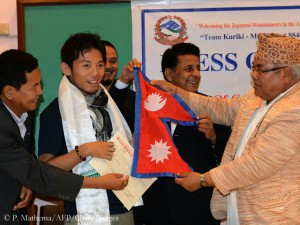
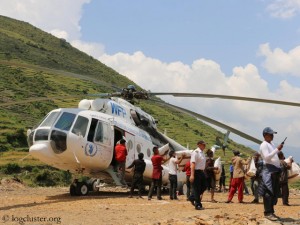
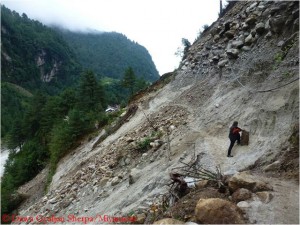
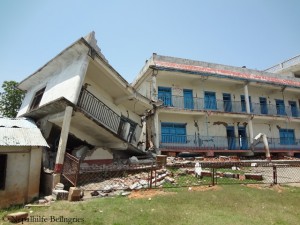
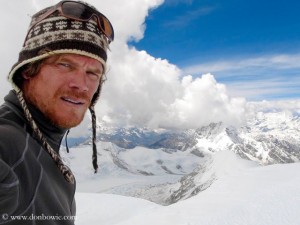
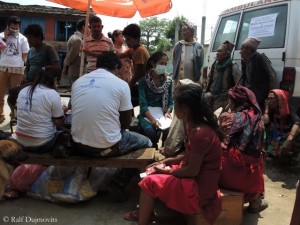
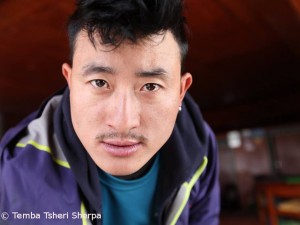
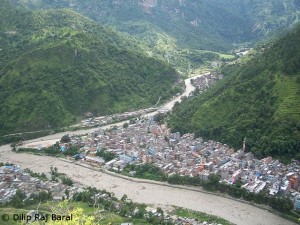
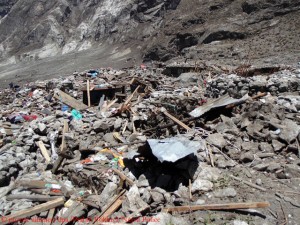
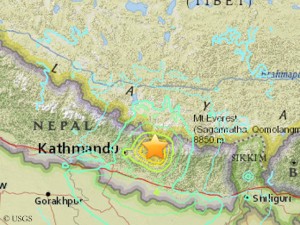
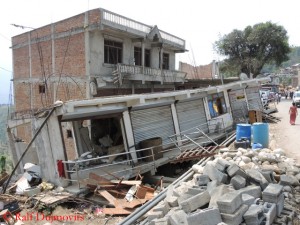





Feedback